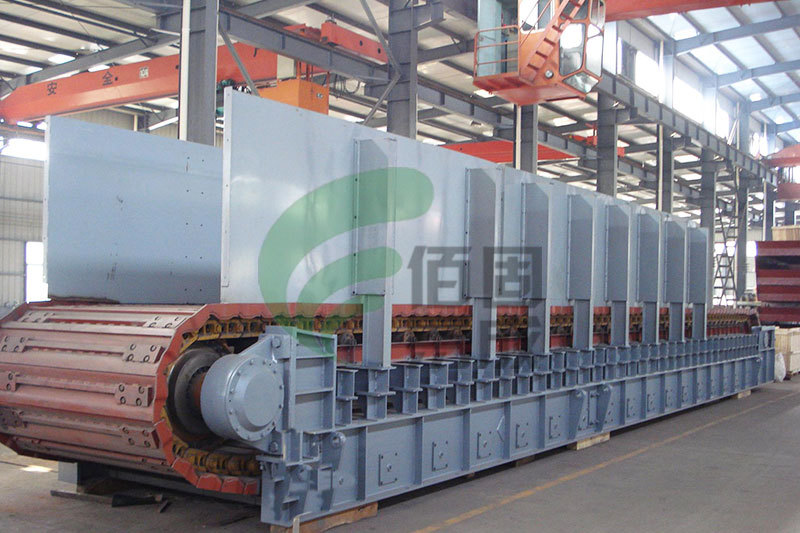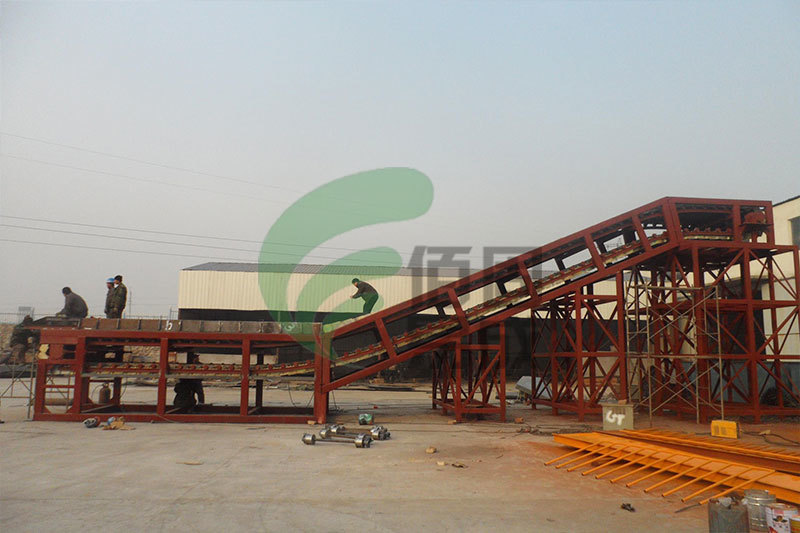Products
ZBLHeavy Duty Chain Plate Machine
ZBL Heavy Duty Chain Plate Machine (abbreviated as Chain Plate Machine), is improved and designed on the basis of BLQ series medium-sized plate feeder.
Key words:
Key words:
ZBLHeavy Duty Chain Plate Machine
Details
 Product Overview
Product Overview ZBL Heavy Duty Chain Plate Machine (referred to as Chain Plate Machine) is improved and designed on the basis of BLQ series medium-sized plate feeder. Plate components are added between the chains on both sides of the chain-plate conveyor to achieve conveying of articles with irregular shape, and special fixtures are added to the chain plates, and it can be used as an assembly line according to the requirements of the working conditions, or plastic steel flat-top chain or stainless steel flat-top chain can be used as the conveying carrier directly. Curved conveyor can be realized. Between the active sprocket and the reversing sprocket, there are two ring chains around, the chain hook is linked with the chain plate, two rollers are added on both sides of the chain plate, and the weight of the material is evenly pressed on the two rollers, and the driving device transmits the power to the sprocket to drive the ring chain and the chain plate to run, so as to achieve the purpose of conveying the material, and it is more suitable for long-distance conveying comparing with the lightweight chain plate conveyor of BLQ.
Chain conveyor is the best conveying equipment for high temperature materials, it can also be used for conveying other bulk, lumpy and granular materials, it has been widely used in building materials, metallurgy, mining and other industries for material conveying.
 Product Classification
Product ClassificationChain conveyors are available in a variety of structural types. Chain plate conveyor can be generally categorized as follows:
1、According to the installation form of the conveyor, it can be divided into fixed type and mobile type;
2、According to the arrangement of the conveyor, it can be divided into horizontal type, horizontal-inclined type, inclined type, inclined-horizontal type, horizontal-inclined-horizontal type and so on;
3、According to the structure type of traction member, it can be divided into sleeve roller chain type, stamping chain type, casting chain type, ring chain type and detachable chain type;
4、According to the number of traction chains, it can be divided into single chain type and double chain type;
5、According to the structural type of the bottom plate, it can be divided into scale plate type (with baffle wave type, without baffle wave type, with baffle deep type, etc.) and flat plate type (with baffle flat type and without baffle flat type, etc.);
6、According to the running characteristics of the conveyor can be divided into continuous and pulsating type;
7、According to the driving method, it can be divided into electric machinery driving type and hydraulic driving type.
 Scope of application
Scope of application 1, in addition to the viscosity of particularly large materials, general solid materials and pieces can be used to convey it;
2、High conveying capacity;
3, the strength of traction chain is high, can be used for long-distance conveying;
4、Flexible arrangement of conveying route, compared with mesh belt conveyor, chain conveyor can be conveyed under the condition of larger inclination angle and smaller bending radius, so the arrangement is more flexible. The inclination angle of chain plate conveyor can reach 30°-35°, and the bending radius is generally about 5-8m;
5, in the conveying process can be sorted, dried, cooled or assembled and other kinds of process processing.
 Product Features
Product Features Chain plate machine has reasonable structural design, good performance, low running resistance, few wearing parts, safe operation, convenient maintenance, reliable operation and long service life. The chain plate machine can be installed horizontally or at an inclination of <30°, and when installed at an inclination, it is equipped with a ratchet backstop mechanism.
The roller on the conveyor chain plate rolls on the guide rail, and there is no friction between the conveyor chain and the casing; the chain is made of alloy steel heat-treated and processed, and its normal service life is about 2 years, with low failure rate in operation. In addition to the head and tail bearings, there is no lubrication point in the conveyor.
The advantages of chain conveyor relative to its conveying equipment:
1、With the plate chain as the traction element, it is not only strong, efficient and reliable, but also can be used for long-distance conveying (at present the conveying length is up to 1,000 meters), with large conveying capacity.
2, the traction chain can be installed on a variety of structural attachments to meet the different requirements for the transportation of different materials to achieve a variety of continuous process, this performance is not comparable to other types of conveyors.
3、Compared with the belt conveyor, the support type conveyor can convey materials under the condition of larger inclination angle and smaller bending radius. The inclination angle of the plate conveyor can be up to 30 ° ~ 35 °, the bending radius is generally about 3m-5m.
4, can convey higher temperature materials (600 ° ~ 700 °), can also adapt to the more demanding conditions, such as heavy logs, sharp edges of the ore and harmful chemicals.
 fabric
fabric
The chain plate machine consists of head frame, head guard, active sprocket set, material conveying device, middle frame, tail frame, redirecting sprocket set, chain plate pallet set and driving device.
The driving device consists of motor, pin coupling, JZQ reducer and driving base. There are two kinds of right and left mounting, from the rear of the machine to the conveying direction, the driving device is right mounting on the right side and left mounting on the left side.
The sprocket adopts assembled structure, which is made of cast steel sprocket ring and sprocket core bolted together, with strong wear-resisting performance and easy to dismantle and install. The active sprocket adopts the eye sprocket ring to prevent the chain from sliding during operation.
 Technical Parameters
Technical Parameters| norm | Spindle speed(r/min) | running speed(r/min) | transport volume(m³/h) | drive unit | ||
| wheelbases(m) | power (output)(kw) | Reducer (model) | ||||
| 500 | 1.54 | 2.77 | 14 | ≤20 | 5.5 | JZQ400 |
| 20-50 | 7.5 | JZQ500 | ||||
| 650 | 1.54 | 2.77 | 20 | ≤10 | 7.5 | JZQ400 |
| 10-40 | 11 | JZQ500 | ||||
| 40-60 | 15 | JZQ500 | ||||
| 800 | 1.68 | 3.64 | 40 | ≤30 | 15 | JZQ500 |
| 30-50 | 18.5 | JZQ650 | ||||
| 50-70 | 22 | JZQ650 | ||||
| 1000 | 1.68 | 3.64 | 56 | ≤30 | 18.5 | JZQ650 |
| 30-50 | 22 | JZQ650 | ||||
| formality | Conveyor widthB(mm) | Conveying speed V (m/min) | Side panel heightH(mm) | Conveyor chain pitchP(mm) | Maximum conveying capacityQ(m³/h) |
| light (machinery, aircraft etc) | 400 | 1.8-3.0 | 100 | 200-250 | 10 |
| 500 | 100 | 15 | |||
| 650 | 125 | 20 | |||
| 800 | 160 | 320 | 25 | ||
| large caliber | 800 | 0.8-3.0 | 160 | 320 | 25 |
| 1000 | 160 | 30 | |||
| 1200 | 200 | 320 | 50 |
Related Products
Online message








